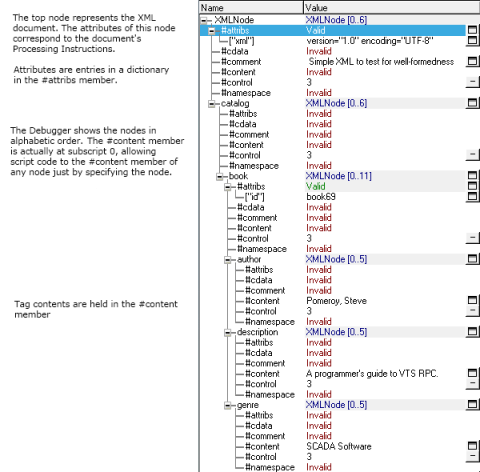XMLNodes
An XMLNode has 6 members known respectively as: #content, #attribs, #namespace, #control, #cdata and #comment. If an XML tag has child tags, then they are represented as additional members of the structure.
For example, given the following XML code:
<?xml version="1.0" encoding="UTF-8"?>
<!-- Simple XML to do a test for well-formedness -->
<catalog>
<book id="book42">
<author>Pomeroy, Steve</author>
<title>RPC Manual</title>
<genre>SCADA Software</genre>
</book>
</catalog>
This would be represented in VTScada by the following XMLNode structure:

The fact that the #content member is at subscript [0] enables script code to take advantage of automatic subscription into arrays, to refer to the #content member of any node just by specifying the node. For example, to access the book title, assuming the XMLNode tree is held in variable "XMLNodes", use the following code:
XMLNode\catalog\book\title
All other members can be accessed via Scope():
Scope(XMLNode\catalog\book, "#attribs")
Both these constructs can be used on either side of an assignment.
The purpose of the 6 standard members of the structure are as follows:
|
Member Name |
Purpose |
|---|---|
|
#content |
The textual content of the tag. |
|
#attribs |
A dictionary containing the attributes of the tag. |
|
#namespace |
A string representing the namespace the tag belongs to. |
|
#control |
An internal use field. Used by XMLWrite to spot loops. |
|
#cdata |
A string representing any CDATA associated with the tag. |
|
#comment |
A string representing a comment associated with the tag. |
All members can be both read from and written to, but note that the #control member will be altered by XMLWrite() when processing the XMLNode tree. As each node is visited, the #control member is set to a unique value for that call to XMLWrite(). If a node already has the unique value when visited then a loop has been found and writing terminates at that point. An error is returned.
Accessing a portion of an XMLNode tree.
Take care when writing code to access a portion of an XMLNode tree. You should use either the address-of operator (&) to pass a pointer, or use XMLGetNode() to extract the node of interest:
MySub(&(XMLNode\catalog\book));
or
MySub(XMLGetNode(XMLNode\catalog\book);
Note that the first version will require the use of the dereference (*) operator on every access.
